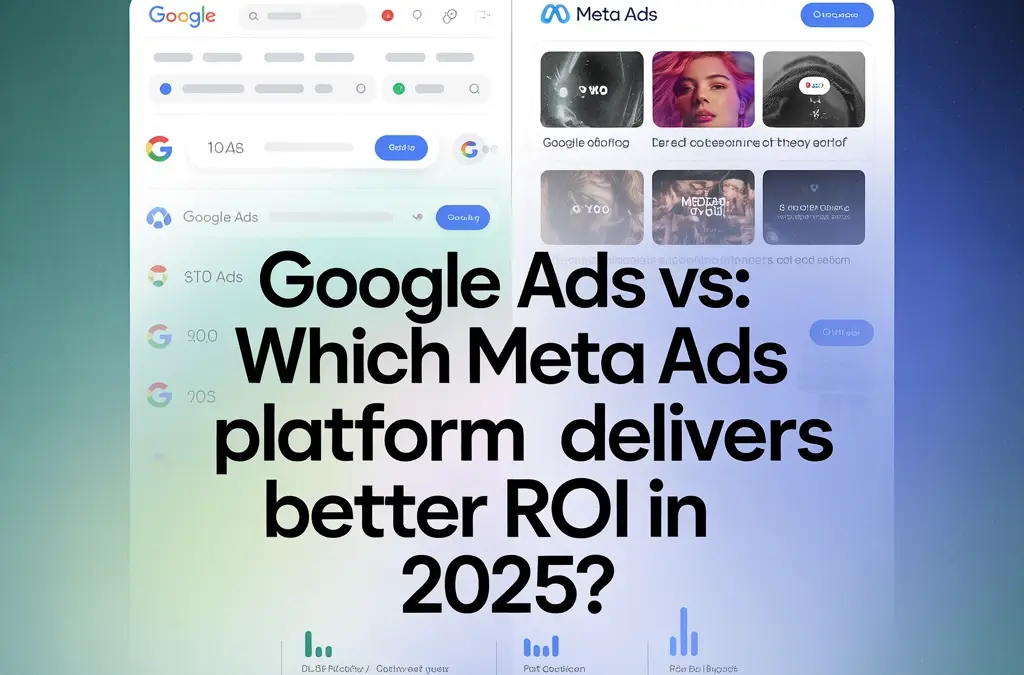The eternal question that keeps digital marketers up at night: Google Ads or Meta Ads? After analyzing the latest 2025 performance data and working with countless international businesses, the answer isn't as straightforward as you might think. Both platforms have evolved significantly, and choosing the wrong one could cost you thousands in wasted ad spend.
Here's the reality check: Google Ads delivers an average ROI of 8:1 compared to Meta's 2.5:1, but Meta Ads cost significantly less to run. The real winner depends entirely on your market, business model, and where your customers hang out online.
Google Ads: The Intent-Driven Powerhouse
Google processes over 8.5 billion searches daily, making it the ultimate demand capture machine. When someone types "best pizza delivery near me" or "emergency plumber Bangkok," they're not browsing—they're ready to buy.
The Numbers That Matter:
- Average CPC: $2.69 to $5.26 (varies by industry)
- Conversion rate: 3.75%
- Click-through rate: 3.17%
- Reach: 90% of internet users globally
Markets Where Google Ads Dominate
Local Services & Emergency Providers
Plumbers, electricians, locksmiths, and medical services see incredible ROI on Google Ads. When your toilet's flooding at midnight, you're not scrolling Instagram for solutions—you're Googling "emergency plumber." These high-intent searches convert at rates often exceeding 10%.
B2B Software & Professional Services
Companies selling CRM software, accounting services, or marketing tools thrive on Google Ads. Business decision-makers actively search for solutions to specific problems. A well-optimized campaign for "project management software for construction companies" can deliver qualified leads at predictable costs.

E-commerce with Established Product Demand
If people already know they want your type of product, Google Ads is your goldmine. Searches like "wireless noise-canceling headphones" or "organic dog food delivery" indicate strong purchase intent. Google Shopping campaigns particularly excel here, showing product images and prices directly in search results.
High-Value Services
Legal services, real estate, financial consulting, and other high-ticket offerings benefit from Google's intent-based targeting. When someone searches "divorce lawyer in Copenhagen," they're serious about hiring someone—and willing to pay premium rates for the right expertise.
Meta Ads: The Discovery & Engagement Champion
Meta's ecosystem reaches 3 billion monthly active users across Facebook, Instagram, and Threads. It's a discovery platform where people aren't actively shopping—they're socializing, entertaining themselves, and stumbling upon things they didn't know they needed.
The Numbers That Tell the Story:
- Average CPC: $0.97 to $1.50
- Conversion rate: 9.21% (for awareness campaigns)
- Click-through rate: 0.90%
- Reach: 51% of internet users
Markets Where Meta Ads Excel
Lifestyle & Fashion Brands
Instagram's visual-first environment is perfect for fashion, beauty, home decor, and lifestyle products. Users discover new brands through aesthetically pleasing content and influencer partnerships. The platform's sophisticated targeting lets you reach "women aged 25-35 interested in sustainable fashion who live in urban areas."

Consumer Products with Visual Appeal
Food products, gadgets, fitness equipment, and anything that benefits from demonstration videos perform exceptionally well on Meta. The platform's video-first approach lets you show products in action, building desire through storytelling rather than just features.
Brand Building & Awareness Campaigns
New businesses or established companies entering new markets use Meta to build recognition. The platform's advanced psychographic targeting helps you reach people based on interests, behaviors, and life events—not just demographics.
Event-Based Businesses
Restaurants, fitness studios, entertainment venues, and event organizers leverage Meta's local community features. Facebook Events integration and location-based targeting help fill seats for everything from yoga classes to concert venues.
The Platform Showdown: Key Differences
| Metric | Google Ads | Meta Ads |
|---|---|---|
| User Intent | High (actively searching) | Low (passive browsing) |
| Cost Efficiency | Higher cost, higher quality | Lower cost, higher volume |
| Targeting Precision | Keyword-based | Behavior & interest-based |
| Creative Requirements | Text-focused, simple | Visual-heavy, engaging |
| Sales Cycle | Shorter (immediate need) | Longer (discovery to purchase) |
| Best ROI Scenarios | Bottom-funnel conversions | Top-funnel awareness |

Market-Specific Strategies That Actually Work
For International Businesses
Google Ads typically performs better in markets with high search volumes and established internet infrastructure—think North America, Europe, and urban Asia. Meta Ads often deliver better value in emerging markets where social media adoption outpaces search behavior.
Seasonal & Holiday Campaigns
Google Ads dominate during high-intent periods like Black Friday, when people search specifically for deals. Meta Ads work better for building holiday anticipation and showcasing gift ideas through engaging visual content.
Mobile-First Markets
In regions where mobile internet usage exceeds desktop (most of Asia, Africa, and Latin America), Meta Ads often provide better reach and engagement rates. Instagram Stories and Reels perform particularly well in these markets.
The Smart Money Strategy for 2025
The most successful businesses don't choose between Google and Meta—they use both strategically. Here's the framework that actually works:
Phase 1: Build Awareness (Meta Ads)
Start with Meta to introduce your brand and educate potential customers. Use engaging video content and targeted interest-based campaigns to build an audience of people who've interacted with your brand.
Phase 2: Capture Intent (Google Ads)
Run Google Ads campaigns targeting keywords related to your product or service. Focus on bottom-funnel terms that indicate buying intent.
Phase 3: Retargeting Bridge (Both Platforms)
Retarget Meta audiences who engaged but didn't convert through Google Ads when they search for related terms. Simultaneously retarget Google visitors through Meta with compelling visual content.

This integrated approach leverages Meta's cost-effective awareness building while capitalizing on Google's superior conversion rates. Companies using this strategy typically see 40-60% better overall ROI compared to single-platform approaches.
Making the Right Choice for Your Business
Choose Google Ads if you:
- Sell products or services people actively search for
- Need immediate, measurable conversions
- Have higher margins that can absorb increased CPCs
- Operate in competitive, established markets
- Want straightforward ROI tracking
Choose Meta Ads if you:
- Need to build brand awareness or educate your market
- Have visually appealing products or compelling stories
- Target younger demographics (18-34)
- Operate with tighter budgets requiring cost efficiency
- Want to build long-term customer relationships
Use both platforms when:
- You have sufficient budget for integrated campaigns
- Your sales cycle extends beyond immediate purchase decisions
- You want to maximize reach across different customer touchpoints
- You're launching new products or entering new markets
The Bottom Line
Google Ads deliver higher immediate ROI for businesses capturing existing demand, while Meta Ads create demand more cost-effectively. The platform you choose should align with where your customers are in their buying journey and how they discover solutions to their problems.

For most international businesses, the winning strategy combines both platforms strategically rather than choosing one over the other. Start with the platform that best matches your immediate business goals, then expand to create a comprehensive digital advertising ecosystem that captures customers at every stage of their journey.
The key is testing, measuring, and optimizing based on your specific market conditions rather than following generic best practices. In 2025, the businesses that win are those that adapt their platform strategy to their unique customer behavior patterns—not the other way around.





